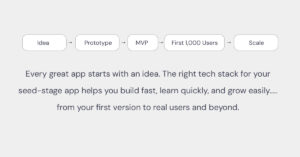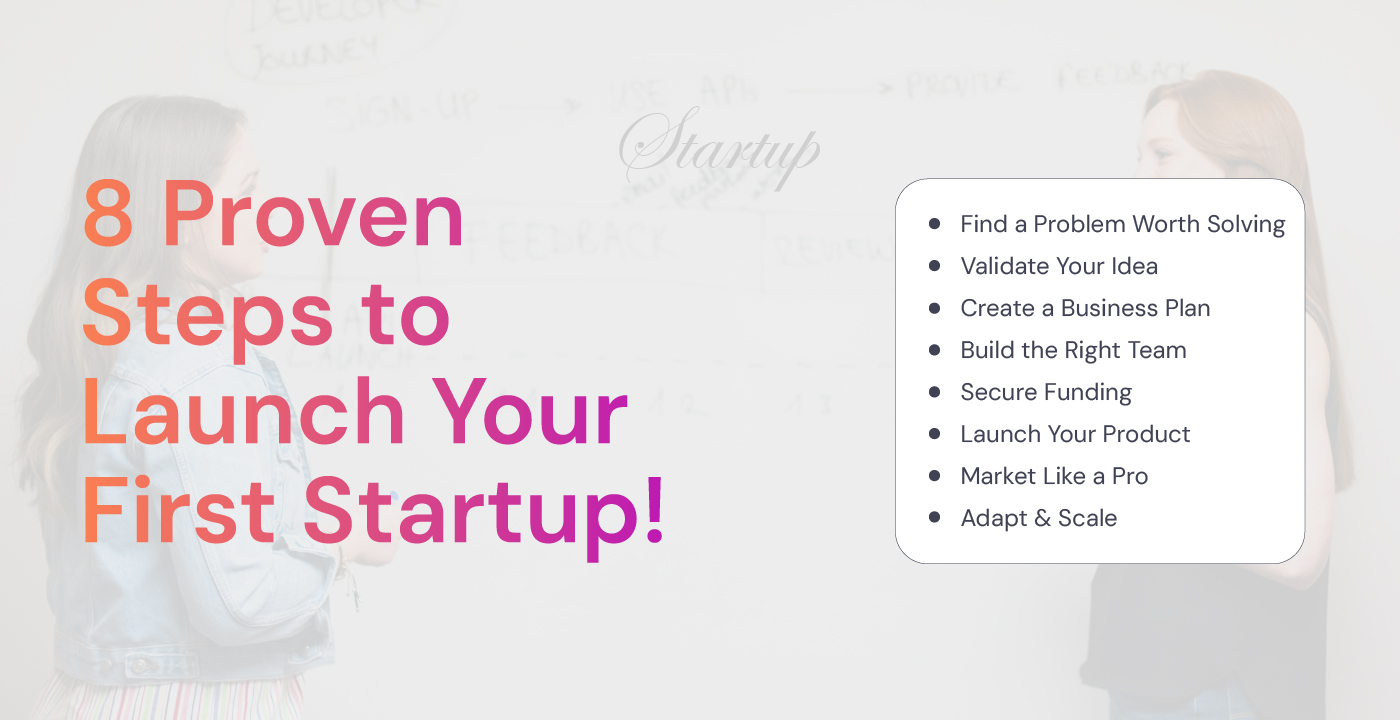Before you write a single line of code, every seed-stage startup faces the ultimate dilemma:
Which tech stack should we use for our app?
At this stage, investors expect progress, users expect reliability, and you are racing against time to build something scalable without breaking the bank.
The right tech stack for startup app development determines how quickly you can build, how much you will spend, and how easily your product can grow once real traction starts.
We have seen founders struggle with this exact decision. Some overbuild early and drown in cost. Others choose tools that can’t scale past 500 users.
If you are still figuring out how to start your startup journey the right way, our 8 Steps to Get Started with Your First Startup guide is a great place to begin.
What Exactly Is a Tech Stack for a Startup App?
A tech stack is just the set of programming languages, frameworks, and tools that make your app work.
It has three main parts: Frontend: What users see. Built with tools like React, Vue, or Flutter. Backend: What runs behind the scenes. built with Node.js, Python, or Ruby. Database & Infrastructure: Where your data lives. Services like PostgreSQL, Firebase, or AWS.
According to recent data, nearly 90% of startups fail within their first few years, and around 6% of those failures are directly linked to poor tech choices or scalability issues. Choosing the right stack early can save you from that trap.
Why do the Tech Stack Decisions Matter So Much at Seed Stage?
At the seed stage, you are proving two things: that your product solves a real problem and that your technology can scale once it does.
Your investors and early customers are watching for traction. If your app crashes, loads slowly, or costs a fortune to maintain, that traction slips away fast.
That’s why you should always ask:
“Can this tech stack get us to 10,000 users without slowing down or draining our budget?”
Because when you pick wrong:
- The wrong tech stack for startup apps forces constant rewrites.
- You spend your funding fixing bugs instead of acquiring users.
- Developers waste time managing infrastructure instead of building features.

3 Core Factors to Pick the Right Tech Stack
It is much-needed to break down what truly matters when choosing your seed stage app technologies.
1. Scalability
You don’t need enterprise architecture right now but you do need a foundation that can grow without rewriting everything.
- For your startup, go with a cloud-based backend like AWS, Google Cloud, or Azure. These make it simple to scale as you grow.
- Pick a reliable backend language such as Node.js or Python. Both are popular and proven for startups.
- Use well-supported frameworks like React, Django, or Express so you can find help and resources easily.
- And most importantly, keep things modular. Design your app so parts can be updated or swapped out as your product evolves.
2. Cost
When you are managing a small funding round, controlling your startup app cost is super-important. High hosting fees, niche developers that cost double or tools that charge per user.
For your startup, do the same:
- Use open-source tools when you can. PostgreSQL, React, and Node.js are great options.
- Don’t overpay for cloud space you don’t yet need. Start small and scale as your user base grows.
- Try Backend-as-a-Service platforms like Firebase or Supabase to save development time early on.
- Keep an eye on recurring costs. Things like APIs, hosting, and analytics can add up faster than you expect.
3. Speed
When you are building at the seed stage, there’s no time for perfect plans. You just need to build, test, and keep moving.
- Pick tools that make life easier, like React or Flutter.
- Set up basic testing early with Jest or Cypress so you don’t waste time fixing simple stuff later.
- Use CI pipelines to push updates without breaking things.
- And don’t overbuild. Focus on what helps you learn from users right now.
The 7-Step Framework for Picking the Right Tech Stack for Startup App
This is an easy framework we use at Doerz Tech to help founders pick the right tools for their app.
1. Know What You are Building
Start with the basics: what’s the main thing your app needs to do?
If it’s heavy on data, focus on getting your backend right.
If design and user experience matter most, spend your energy on the front end.
2. Think About the Next 6–12 Months
Don’t worry about scaling for a million users yet. Plan for your first few thousand.
If you think growth might come fast, make sure your cloud setup can handle it.
3. Be Real About Your Budget
Know how much you can actually spend on tech. Pick tools that fit your budget and don’t hit you with surprise costs later.
4. Pick Tech That’s Easy to Hire For
Stick with popular frameworks like React or Node.js. You can more easily find good developers for them than for niche tech.
5. Go for Strong Community Support
Go for tech that other startups already use.
A big community means more tutorials, support, and quick fixes when you get stuck.
6. Stay Flexible
Your app will grow and change and your tech should grow with it.
Pick tools that work well with others and can be replaced or upgraded easily.
APIs and open integrations are your best friends here.
7. Build, Test, and Improve
Don’t wait for perfection.
Launch fast, get feedback, and keep improving.
Every version teaches you something new and that’s how great apps are built.
If you are new to budgeting for early-stage startups, check out our Founder’s Guide to Startups for a breakdown of how to manage costs while building smart.
Avoid These 4 Common Mistakes in Choosing Your Startup App Tech
These 5 mistakes are to watch out for to stay clear of trouble.
1. Don’t chase shiny tech.
Just because everyone’s talking about a new framework doesn’t mean it’s right for you. Pick what actually fits your product and the people building it. Forget the hype.
2. Watch out for hidden costs.
A lot of tools look cheap at first, but the bills start piling up once users grow. Always look past the free plan. Make sure it’s something you can afford long-term.
3. Keep it simple early on.
You don’t need fancy architecture or microservices yet. Just get something working and in front of users. You can clean up and scale later when it actually matters.
4. Don’t skip security.
Even a small app needs the basics. HTTPS, a safe database that protects user data. It’s way easier to build it right from the start than fix it after something breaks.
The Final Note!
Start with rapid, developer-friendly frameworks like React and Node.js, validate your idea, and then gradually migrate critical modules to more scalable setups as you grow.
Have a big idea and a small runway?
Fill this Quick Form and we will reach out to map out a tech strategy that fits your product, budget, and growth plan.









